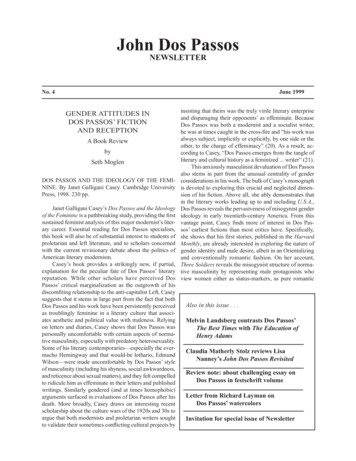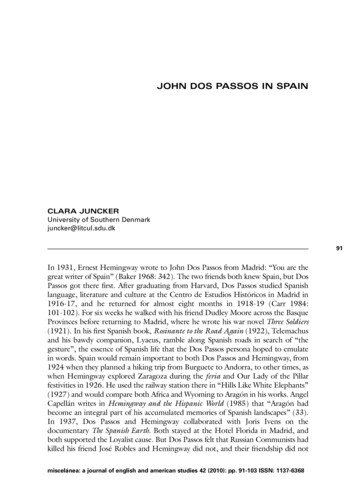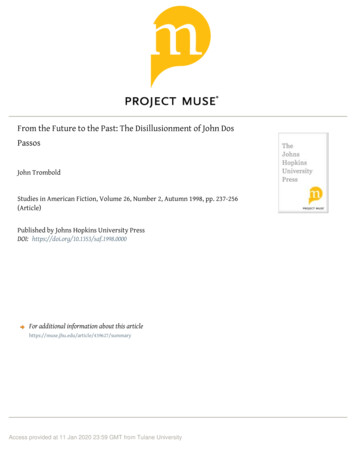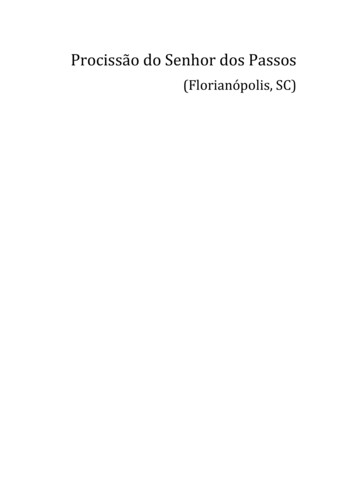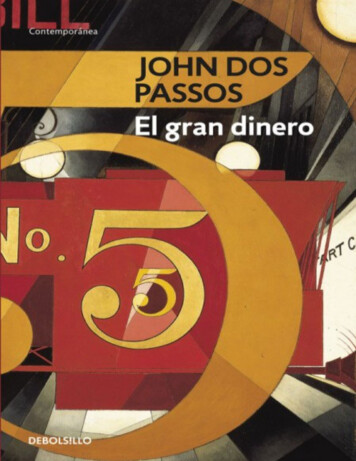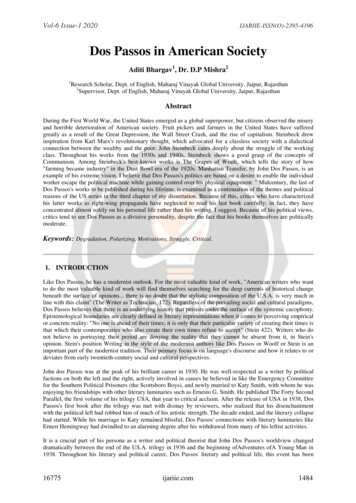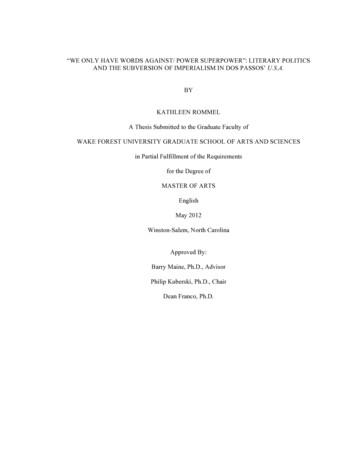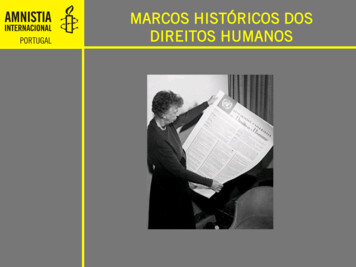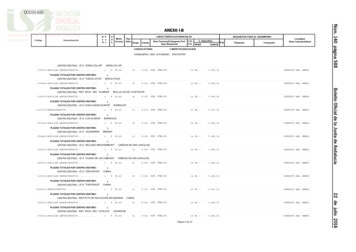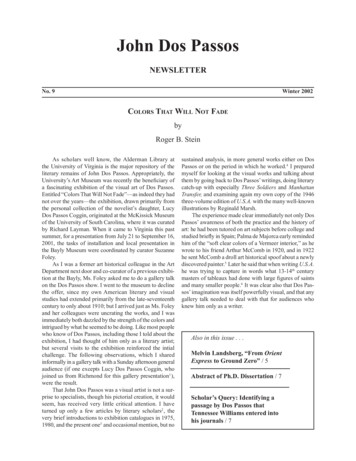
Transcription
Winter 2002 John Dos Passos Newsletter1John Dos PassosNEWSLETTERNo. 9Winter 2002Colors That Will Not FadebyRoger B. SteinAs scholars well know, the Alderman Library atthe University of Virginia is the major repository of theliterary remains of John Dos Passos. Appropriately, theUniversity’s Art Museum was recently the beneficiary ofa fascinating exhibition of the visual art of Dos Passos.Entitled “Colors That Will Not Fade”—as indeed they hadnot over the years—the exhibition, drawn primarily fromthe personal collection of the novelist’s daughter, LucyDos Passos Coggin, originated at the McKissick Museumof the University of South Carolina, where it was curatedby Richard Layman. When it came to Virginia this pastsummer, for a presentation from July 21 to September 16,2001, the tasks of installation and local presentation inthe Bayly Museum were coordinated by curator SuzanneFoley.As I was a former art historical colleague in the ArtDepartment next door and co-curator of a previous exhibition at the Bayly, Ms. Foley asked me to do a gallery talkon the Dos Passos show. I went to the museum to declinethe offer, since my own American literary and visualstudies had extended primarily from the late-seventeenthcentury to only about 1910; but I arrived just as Ms. Foleyand her colleagues were uncrating the works, and I wasimmediately both dazzled by the strength of the colors andintrigued by what he seemed to be doing. Like most peoplewho know of Dos Passos, including those I told about theexhibition, I had thought of him only as a literary artist;but several visits to the exhibition reinforced the intialchallenge. The following observations, which I sharedinformally in a gallery talk with a Sunday afternoon generalaudience (if one excepts Lucy Dos Passos Coggin, whojoined us from Richmond for this gallery presentation1 ),were the result.That John Dos Passos was a visual artist is not a surprise to specialists, though his pictorial creation, it wouldseem, has received very little critical attention. I haveturned up only a few articles by literary scholars2 , thevery brief introductions to exhibition catalogues in 1975,1980, and the present one3 and occasional mention, but nosustained analysis, in more general works either on DosPassos or on the period in which he worked.4 I preparedmyself for looking at the visual works and talking aboutthem by going back to Dos Passos’ writings, doing literarycatch-up with especially Three Soldiers and ManhattanTransfer, and examining again my own copy of the 1946three-volume edition of U.S.A. with the many well-knownillustrations by Reginald Marsh.The experience made clear immediately not only DosPassos’ awareness of both the practice and the history ofart: he had been tutored on art subjects before college andstudied briefly in Spain; Palma de Majorca early remindedhim of the “soft clear colors of a Vermeer interior,” as hewrote to his friend Arthur McComb in 1920, and in 1922he sent McComb a droll art historical spoof about a newlydiscovered painter.5 Later he said that when writing U.S.A.he was trying to capture in words what 13-14th centurymasters of tableaux had done with large figures of saintsand many smaller people.6 It was clear also that Dos Passos’ imagination was itself powerfully visual, and that anygallery talk needed to deal with that for audiences whoknew him only as a writer.Also in this issue . . .Melvin Landsberg, “From OrientExpress to Ground Zero” / 5Abstract of Ph.D. Dissertation / 7Scholar’s Query: Identifying apassage by Dos Passos thatTennessee Williams entered intohis journals / 7
2 John Dos Passos NewsletterBut how to organize a gallery talk? The exhibition asconfigured at Virginia included some 74 works by Dos Passos, organized roughly chronologically from those createdabout 1918 to a very few after 1940, during the later decades of his life, and grouped by subject matter or location.This was its organization for the catalogue and the SouthCarolina venue. The Virginia presentation unfortunatelydid not include six of Dos Passos’ notebooks, which wouldhave given the audience a sense of his working method.But on the other hand, the Charlottesville exhibition didinclude an additional seven works, also generously loanedby Mrs. Coggin for this particular venue, a sampling ofthe art done by Dos Passos’ painter colleagues and ownedby him. These latter included two small oils by the Frenchmodernist Fernand Léger, tokens of their friendship, a large“Le Bistrot” [sic] by the American Abraham Rattner, withwhom Dos Passos collaborated for the magazine Verve inthe early thirties, a large sea scene by Harold Weston, andthree works by Waldo Pierce recalling their shared timeat Key West in 1929. Dos Passos’ own works were onthe whole small in scale: a frustratingly limited numberof pencil or pen and ink drawings; a large assortment ofworks in watercolor or gouache (a more opaque form ofwatercolor) which ranged from delicate tones in the earliestthat recalled James Abbot Whistler of the 1870s or eventhe pastel tones of Edouard Vuillard, to bold landscapesin strident primary colors, which suggest the influence ofeither the French Fauves of about 1905 or the Germanexpressionists of the next decade. Another grouping included a striking poster, “Processional,” and other workscreated in relation to the dramas of John Howard Lawsonand for Dos Passos’ The Moon is a Gong and still moreof his radical theatrical work in the 1920s. In some waysone of the most interesting displays was a large vitrineTHE JOHN DOS PASSOS NEWSLETTERThe Newsletter seeks to promote scholarship onand interest in Dos Passos’ writings and biography,and will publish short articles on these subjects. Itwill also publish news items, notes, letters, andqueries on these and other relevant matters. Amongthese matters are work in progress, manuscript locations and accessions, bibliographies, and textualscholarship.For return of manuscripts, contributors shouldsend, along with their submissions, stamped envelopes addressed to themselves. They should addressall queries and manuscripts to the editor, MelvinLandsberg, Department of English, University ofKansas, Lawrence, KS 66045-2115.COPYRIGHT 2002 by Melvin LandsbergAll rights reserved.Winter 2002containing Dos Passos’ dustjackets for his own literaryworks, because here we find Dos Passos himself visuallyinterpreting his own verbal production.Which leads us back to the initial question of how tocope with such an exhibition. A visual work of art is not a“reflection” of its artist’s life or of a time or place or idea,any more than is a poem or play or novel. Reflection theory,however benign in intention, is fundamentally mistaken,because it denies the contingency of art and its constitutivefunction. Visual works inevitably interpret, through styleand form, through the choices made about subject matter.Students of Dos Passos surely know this about U.S.A.,that it is an interpretation, rather than a “reflection” of itstime; we must grant the same to visual artifacts. The images in this exhibition, themselves only a selection fromhis total visual output, are the work of a competent artist,who handles his media well, sometimes delicately, mostlyforcefully, capturing his impressions of place or person.Stylistically, Dos Passos as visual artist was not aninnovator, boldly pushing against conventional ways ofmaking of his time, though he showed awareness of visualconventions of both the past and the present. Where Manhattan Transfer and U.S.A. draw upon film, radio, and othermedia to redefine the novel as form, recasting the rolesof narrative and character, in the visual work available inthis exhibition one picks up “influences” and shifts overtime, though without any single linear development of thekind critics have traced in his fictional life. Thus one cansee echoes of the important early modernist theorist andpractitioner Arthur Wesley Dow (Georgia O’Keeffe’s earlymentor) or of Whistler in Dos Passos’ earliest landscapeshere of about 1918, but within a few years the impact ofHenri Matisse and the Fauves—they had been working in1905 and thereabouts—are visible in Dos Passos’ muchmore schematic and abstract landscape views, and elements of cubism in his figural studies, obviously indebtedto Picasso, whom he knew through the Murphys.7Passages from Three Soldiers which I read to thegathered group made clear how much Dos Passos imaginedin color and spatial terms:At the brow of the hill they rested. Chrisfield saton the red clay bank and looked about him, hisrifle between his knees. In front of him on theside of the road was a French burying ground,where the little wooden crosses, tilting in everydirection, stood against the sky, and the beadwreaths glistened in the warm sunlight. Alldown the road as far as he could see was a longdrab worm, broken in places by strings of motor trucks, a drab worm that wriggled down theslope, through the roofless shell of the village andup into the shattered woods on the crest of thenext hills. Chrisfield strained his eyes to see thehills beyond. They lay blue and very peaceful inthe noon mist. The river glittered about the piers
Winter 2002 John Dos Passos Newsletterof the wrecked stone bridge, and disappearedbetween rows of yellow poplars. Somewherein the valley a big gun fired. The shell shriekedinto the distance, towards the blue peaceful hills.(Opening of part 3, chap. 5)The contrast between this precisely seen mostly gray,mostly tonal vision of Chrisfield—it reminds one ofStephen Crane in The Red Badge of Courage or even theCivil War landscapes of Whitman’s Drum Taps—and theurban eye of John Andrews in the opening chapter of partfive is striking:He hurried into the gardens. Many people saton benches in the frail sunlight. Children inbright-colored clothes ran about chasing hoops.A woman paraded a bunch of toy balloons incarmine and green and purple, like a huge bunchof parti-colored grapes inverted above her head.Andrews walked up and down the alleys, scanning faces. . . .Clearly the author of this passage (and his musicianartist eyes of Andrews) has impressionist city scenes inmind when shaping prose like this. In the Bayly exhibition,a watercolor “View from the Upper Part of the Coliseumof Bicycle Racers,” dated ca. mid-1920s, looks downabruptly from the upper decks of the Velo d’Hiver in Paris,which Dos Passos attended with Hemingway (it was laterinfamous as the place where the Nazis herded ParisianJews). To my mind the image recalls both a famous earlyJohn Singer Sargent oil of a rehearsal at the Cirque d’Hiver(1876; Boston, Museum of Fine Arts), and numerous Degasballet scenes, with their exaggerated perspectives. Thepoint here is not some simple mechanical notion of “influence,” though Dos Passos’ large familiarity with art doesn’trule out his possible recollection. What is crucial in all ofthese examples are ways of seeing, critical points of view,angles of vision which (as any student of Henry Jamesknows) are not mechanical devices but epistemologicalstrategies, visual and verbal. These examples enjoin us tolook back and forth with greater care and larger questionsat Dos Passos’ visual performance.The small urban watercolor scenes of skyscraperNew York are surely not major visual achievements, not“masterpieces,” in their own right. For the student of DosPassos and of Manhattan Transfer (1925) in particular,of the skyscraper and New York, and of the culture ofthe 1920s, they function in interesting ways within thesecontexts. Again the movement from the representationalto the abstract, with various experiments in design (notalways successful). Yes, Dos Passos lived in Brooklyn atcertain points and in 1927 in a building with Hart Crane,and the Brooklyn Bridge was part of his life on the wayto Manhattan; but the visual tradition of the Bridge was3a strong one, from the Roeblings’ monument itself (completed 1883) to the series of watercolors which John Marindid, initially in 1910 but also in the mid-twenties and intothe 1930s. A number of these were exhibited by AlfredStieglitz in his famous New York galleries, of which DosPassos was surely aware, and the same can be said of theoil versions by Joseph Stella, who formed part of the Société Anonyme in New York. The four urban watercolorsin the Dos Passos group at the Bayly along with the dustjacket which he created for the first edition of ManhattanTransfer (loaned for the exhibition by Richard Layman)function within this world, and their forms put us in touchboth with the visual world in which he was living and withthe new verbal ways of spatializing in the fiction he wascreating at this moment. The watercolors are dated “ca.mid-1920s,” and a label reminded us: “He exhibited a worktitled ‘East River, New York’ and two titled ‘Manhattan’in the spring and fall 1925 Salons of America exhibits.”Good clues for further inquiry, but a caveat is necessaryhere: most of the titles of works in the exhibition are curatorial descriptions and generic, and the dates assigned onthe labels are only approximate, as the curators were wellaware. More precise work still needs to be done, and notjust to calibrate influences and interactions.The exhibition created groupings of his travel sketcheswhich were labeled as from the mid-1920s in Moroccoand both ca. 1928 and ca. 1932 in Mexico. Some of theseare figure studies, which along with other earlier portraitstudies are, in my view, the weakest part of the exhibitionwith one exception: a lovely pencil portrait of his artistfriend Adelaide Lawson. Otherwise, they may memorializefriendships or distance as “picturesque” people of othercultures, but visually on the whole they lack strength orindividuality. (What one might want to say comparativelyabout Dos Passos’ strengths or weaknesses as a creator offictional individuals is an interesting question.) Layman’stextblocks for these sections in the exhibition helpfullylocated the work within Dos Passos’ interests and friendships and writings: the creation of Orient Express (1927),which Dos Passos himself illustrated, his friendship withDiego Rivera and the Mexican muralists in relation to theirrevolutionary activities—all suggestive contexts whichneed further exploration to clarify the significance of theexplicitly visual consequences. A brief exciting groupelicits Dos Passos’ participation in set design for his andJohn Howard Lawson’s socialist theatrical projects, andthen we are back to Mexican images.The final section of the exhibition, “Focus on America1934-1970,” was disappointing. The textblock argued theMarch 1937 death of José Robles as the turning point inhis life, but rather blandly concludes: “for the rest of hiscareer, Dos Passos’ writing and art focused more intentlyon American subjects.” The visual evidence we are offeredconsists of an undated and unidentified “Political Convention” image (obviously Democratic, given the clearly
4 John Dos Passos Newslettervisible F.D.R banner, but which convention? It could beimportant); a “Wiscasset, Maine” landscape, which evokesthat most painful period of recovery after the death of hisfirst wife, Katharine; a pair of small still lifes from the1960s and an image of a black “Banana Man” with noexplanation. Clearly for the student of Dos Passos’ life andwork, nothing of the political drama, the personal tragedy,the struggles and achievements of these later decades isconfronted in this exhibition. I wondered specifically,for example, how the loss of one of his eyes affected hiswork as visual artist. At the University of Virginia venue,one missed perhaps especially the local connections: tohis Virginia home at Spence’s Point during these years,to any visual sign of his preoccupation with Thomas Jefferson, or of his time at the University, the beneficiary ofso many of his papers, including visual materials on loanfrom Mrs. Coggin. The exhibition’s coda of those sevenworks by other artists which he owned was a nice note. Butone comes away from this exhibition both with gratitudeto those who made possible the opportunity to see an impressive and intriguing gathering of some of Dos Passos’visual expressions, and an even stronger sense that thereal task still is ahead: taking his visual art seriously notas “reflecting” his life and work nor trying to inflate it asmajor independent visual achievement nor vaguely labelling it and him as “impressionist” or “expressionist,” butexamining these and the whole range of his visual oeuvrefor the particular insights which they can offer us abouthis aesthetics, his notions of form and his interpretationsof his subjects over time, what he learned from others andhow that connected him (and us) to a visual and intellectualworld within which he functioned in important ways.Notes1. Mrs. Coggin was both generous and diffident about herfather’s works in the exhibition, all done before her birth, mostmany years before. We are indebted to her stewardship of theworks for their brilliant colors after some eighty years or so:watercolors especially fade badly if exposed to continuous light!2. Most notably George Knox, “Dos Passos and Painting,” Texas Studies in Literature and Language 6 (1964), 22-38,reprinted in Allen Belkind, ed., Dos Passos, the Critics, andthe Writer’s Intentions (Carbondale: Southern Illinois University Press, 1971), 242-64; and the record of his importantcorrespondence with his art historian friend: John Dos Passos’Correspondence with Arthur K. McComb or “Learn to Sing theCarmagnole,” narrated and edited by Melvin Landsberg (Niwot:University Press of Colorado, 1991).3. Just after the Dos Passos papers went to the Universityof Virginia, the Library produced John Dos Passos, Writer andArtist 1896-1970; A Guide to the Exhibition . . . January – April1975, compiled by Anne Freudenberg and Elizabeth Fake withspecial assistance and an Introduction by Townsend Ludington(the catalogue does not list which paintings were displayed);secondly, Paintings and Drawings by John Dos Passos: organizedby the Virginia Museum, Richmond, February 26 through April,6, 1980, some 16 pages in all; and Colors That Will Not Fade:Winter 2002The Art of John Dos Passos, originally mounted at the McKissickMuseum, University of South Carolina, 14 March to 4 April 1999,with a three-page introduction and brief sectional paragraphs bycurator Richard Layman, from which the University of VirginiaArt Museum labels and textblocks, quoted below, were drawn.4. Jack Potter’s 1950 bibliography of Dos Passos, for instance, lists three items in its “Miscellany” section: two full-pagereproductions of Dos Passos paintings appearing in Esquire in1934, one illustrating an article by Ernest Hemingway (January1934), p. 27, the other, entitled “Port of New York,” in the March1934 issue, p. 11; and a Dos Passos painting reproduced on thedust jacket of Pío Baroja, The Quest (New York: Knopf, 1923).Potter also noted a critical commentary which Dos Passos andHemingway did for an exhibition of the paintings of Luis Quintanilla, and a critical introduction, “Satire as a Way of Seeing,”for the Caresse Crosby edition of sixty Georg Grosz drawingsentitled Interregnum (New York: Black Sun Press, 1937). Potter,pp. 64, 90.5. Dos Passos to McComb, April 1920, in Landsberg, Correspondence, p. 141; and, for the spoof, p. 193.6. Cited in Linda W. Wagner, Dos Passos, Artist as American(Austin: University of Texas Press, 1979), p. 86.7. Photographs of the Murphys’ artistic picnics at Antibeshave been frequently reprinted. See, for example, The Fourteenth Chronicle: Letters and Diaries of John Dos Passos, ed.with biographical narrative by Townsend Ludington (Boston:Gambit, 1973), pl. XVII. The “Jazz Age” section of Ludington’sbiography, John Dos Passos, A Twentieth Century Odyssey(New York: E.P. Dutton, 1980), opens with a voluptuous nudedrawing, also in the current exhibition, which to viewers at theBayly Museum looked like the sculpture of Gaston Lachaise inan adjoining gallery. Ludington says he uses these sketches “togive the reader at least some small sense of Dos Passos’ artisticeye,” and adds that “most of these were quickly rendered duringhis travels”(xx). But typically, his own text says very little aboutDos Passos as visual artist.Roger B. Stein, an American Studies scholar who haswritten on both American literary and visual subjects, hasalso curated exhibitions, most recently, with William H.Truettner, the Smithsonian’s Picturing Old New England:Image and Memory (1999). He is now Professor of theHistory of Art Emeritus at the University of Virginia.
Winter 2002 John Dos Passos Newsletter5Rejoicing City that Dwelt Carelessly:From Orient Express to Ground ZerobyMelvin LandsbergAs we turn the pages of John Dos Passos’ short travelbook Orient Express (1927), his eight paintings, eachreproduced on a page of its own, compel our attention.Almost all the paintings are impressionistic, with red,white, yellow, and orange predominating, and convey justhow much of Dos Passos’ Near Eastern trip was throughdeserts and oases, usually under a burning sun.The author’s narrative too is mostly impressionistic.We experience events, but not fully, and analysis is rareand usually fleeting. There is much terrain for the author tocover; he is overwhelmed by sensations and experiences;his verbal record is intermittent, and his visual one hasonly tenuous connections with the text.We note that most of his paintings appear timeless. Thecostumes, the houses, the streets, the bazaars, the oases,the rugs could be from hundreds of years back. DespiteDos Passos’ choice of subject matter for these paintings,it is clear throughout the text that he has a strong sense ofhistory, though in his paintings he has chosen to emphasizethe near-stasis of the area.Dos Passos embarked on the Orient Express train fromVenice in July 1921. After disembarking in Constantinople, he proceeded to the new Soviet republics on theBlack Sea, where he witnessed unforgettable poverty,starvation and disease, all growing out of World War I.Afterwards he traveled in a Soviet railway boxcar to theborder of Persia, and the next day took a train to Tabriz.From there he went in a dilapidated four-horse carriage toTeheran, then by automobile and train to Baghdad, wherehe arranged to travel on by camel caravan to Damascus.Dos Passos’ narrative substantially concludes with his arrival in that city.In March 1923 he wrote a friend that he was planningto write a “novel about New York and go-getters and Godknows what besides.” That novel, Manhattan Transfer,appeared in 1925. Although Orient Express was publishedtwo years after the novel, the Near Eastern experiencespreceded Manhattan Transfer’s writing, and by their contrast with his experiences with New York, influenced thenovel’s form and content.On the train from the Soviet Caucasus to Iran DosPassos became friends with “the Sayyid,” an Iranian whowas returning to his country after completing studies ina German medical school. Dos Passos in Orient Expressdescribes him as a strong proponent of political and tech-nological change in Iran. In a railyard in Nakhtchevan,the author hears him “holding forth on Pan Islam and theresurrection of Persia.” Later, in Iran, the Sayyid tells DosPassos that he is the son of a “mujtahid, a very holy man,”and if he had not gone abroad to study, he might have beena mollah, not a physician. Though not a Baha’i, he believesthat all prophets have a bit of truth, and thinks highly ofthe Baha’is. “But the poor people,” the Sayyid says, “werevery ignorant and fanatic and believed whatever the mollahs told them.”For Persia to be a great nation it must industralize, theSayyid says. “I tried to tell him,” Dos Passos adds, “thatthe life of an industrial worker in Europe and America wasnot all beer and skittles, and even wondered whether thosepeople hammering away at their copper pots, miserablyunderpaid as they were, might not get more out of lifethan, say, the steelworker in Germany, for all his movingpictures and bierhalle with which to amuse himself.”Later, in Baghdad, an old Arab explains to Dos Passosthat Great Britain and France had not acted according toWoodrow Wilson’s Fourteen Points. “The Americai musttell his countrymen that the people of Iraq would continueto struggle for their freedom and for the principles announced by Sheikh Washiton and Meester Veelson.” TheArab people would not, he says, be deceived with kingskept in power by the English.Dos Passos’ subsequent trip by camel caravan to Damascus lasted thirty-seven days. Protected by Jassem erRawwaf, an Agail Arab who was a leader of the caravan,he survived raids by brigands which could have cost himall his possessions, if not his life. During the journey adiscussion of America developed among the Agail. Someof their people had been there and reported that it was aplace full of money. “I made a great speech,” Dos Passoswrites, “and said that if I had any sense I would live in thedesert with the Agail and never go back; but they took itas a compliment and did not understand.”New York City, the subject of Dos Passos’ 1925 novel,was the epitome of American industrial capitalism—thenation’s financial, trade, and cultural center. The population in the city was huge, the anonymity unsurpassed,the economic competition hectic, the pace hasty, and thecontrasts between rich and poor glaring. Dos Passos’ bookabout New York is a collective novel, with scores upon
6 John Dos Passos Newsletterscores of characters, many of whom appear infrequently,or only once. It covers twenty years of the city’s history,beginning around 1900.Although Dos Passos has a painter’s eye for the lightsand colors of the city, his emphasis is overwhelmingly onthe society itself. The novel depicts the post World War Idepression, the conformity that business success requires,the quiet and sometimes noisy desperation of countlesspeople, the crooked actions of business and politicalleaders, the insipidity of the commercial theater, and thedeportation of anarchists by the Federal government.The third and final section of the novel begins afterthe end of World War I, and the period covered is nearlycontemporaneous with that of Orient Express. Part I of thatsection, titled “Rejoicing City That Dwelt Carelessly,” hasJimmy Herf, the leading character, returning from overseasmarried to Ellen Thatcher, a beautiful young actress. Herfis an idealistic journalist, but no one will pay him to writeabout society and events as he sees them. Since he is a“failure,” Ellen abandons Herf and agrees to marry therising, dishonest politician George Baldwin. At the closeof the book a penniless Herf abandons New York, desiringsimply to get away from the city.The novel again and again foretells Nemesis for NewYork. Thus in “The Burthen of Nineveh,” the final section of the novel—immediately following a section titled“Skyscraper”—a tramp in a park says to two boys:“Do you know how long God took to destroy thetower of Babel, folks? Seven minutes. Do youknow how long the Lord God took to destroyBabylon and Nineveh? Seven minutes. There’smore wickedness in one block in New York Citythan there was in a square mile in Nineveh. . . .”On September 11, 2001, the rejoicing city that dweltcarelessly suffered an attack, not from Bible-citing activists, but by Muslim suicidals. And the twin towers of theWorld Trade Center were reduced to “Ground Zero.”Muslim elements like those who, according to the Sayyid,would believe whatever the mullah told them are vastlymore dangerous today, in a shrunken and more technological world, than their counterparts could have been in 1921.As we ponder Ground Zero we spy not poetic justice buta zany conundrum.1Rereading Orient Express after September 11, wewish that Dos Passos had interrogated the Sayyid closelyabout those ignorant fanatics and their mullahs—were themullahs calling for jihads? If so, against whom? But hehad capitalist industrialism, not Near Eastern mullahism,on his mind in 1921.And with adequate reason, as his “biography” of HenryFord in The Big Money later demonstrated so memorably.Winter 2002Nor is capitalist industrialism anything to cheer abouttoday; e.g., its incessant advertising denies our intellectsand fogs our spirits. No writer has evident answers to ourproblems, but Dos Passos’ Orient Express and ManhattanTransfer, though of lesser magnitude than U.S.A., can stillgive us light.Notes1. In contrast, the television evangelist Jerry Falwell twodays after the attack said that God had allowed America’s enemies“to give us probably what we deserve.” Falwell later apologized.Washington Post, September 14, 2001, p. C03; September 18,2001, p. C04. Both citations are from the World Wide Web.
Winter 2002 John Dos Passos Newsletter7Abstract of Ph.D. DissertationScholar’s QueryWe attempt to publish abstracts of recent dissertationson Dos Passos that may be of interest to our readers. Suchpublication depends, however, on receiving the author’spermission.The Editor of the forthcoming volume of the Journalsof Tennessee Williams, to be published by Yale UniversityPress, is seeking the source of the following quotation attributed to Dos Passos:“Managing Materials: Montage and the Representationof Totality in Depression-era Fiction (John Dos Passos),”by Mark Stuart Frankel. 213 pages.This dissertation examines the intersections betweenaesthetic form and political commitment during the 1930s.Beginning with an argument that one cannot read politicsin direct relation to aesthetic form, this project exploresthe forces and ideologies that led so many critics to dojust that. The dissertation looks closely at the rhetoric ofhope that surrounded the complex novel, a literary formnow almost forgotten. In the 1930s, however, Americanleftists championed the complex novel—perhaps bestexemplified by John Dos Passos’ U.S.A.—as a literarymode uniquely capable of representing the forces at workin contemporary capitalism. Neither B
John Dos Passos NEWSLETTER No. 9 Winter 2002 As scholars well know, the Alderman Library at the University of Virginia is the major repository of the literary remains of John Dos Passos. Appropriately, the University's Art Museum was recently the beneficiary of a fascinating exhibition of the visual art of Dos Passos.
